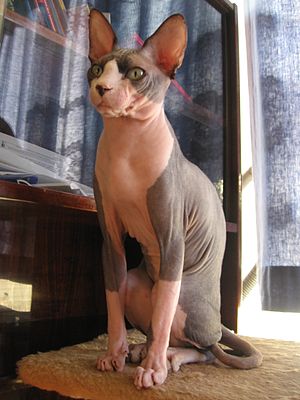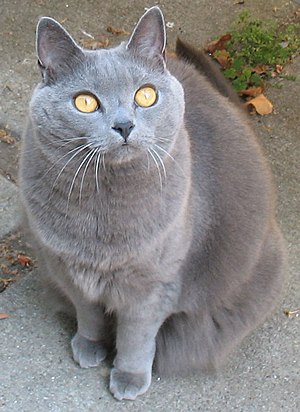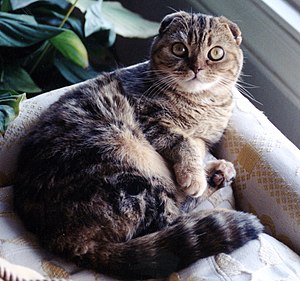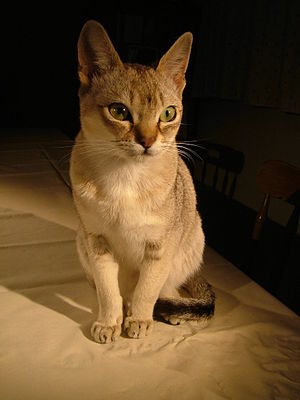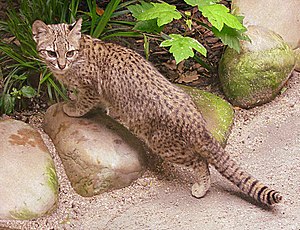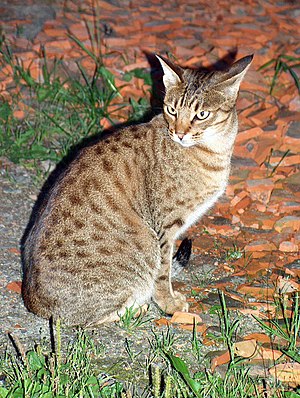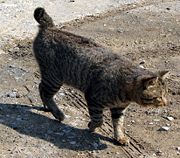Difference between revisions of "AY Honors/Cats - Advanced/Answer Key"
(/* a. The domestic cat known as Sphynx first appeared in the late 1960s. Which of the following is true about this Canadian breed?<br>(1) It is too wild to be a proper house cat.<br>(2) It is the nati) |
|||
| (3 intermediate revisions by the same user not shown) | |||
| Line 5: | Line 5: | ||
==2. Know about cats "open-book" quiz. (This is not an instructional pass-a-test requirement, it is designed to encourage research into the world of cats.) Enjoy new discoveries as you research the following questions about some unusual domestic cat breeds from around the world.== | ==2. Know about cats "open-book" quiz. (This is not an instructional pass-a-test requirement, it is designed to encourage research into the world of cats.) Enjoy new discoveries as you research the following questions about some unusual domestic cat breeds from around the world.== | ||
===a. The domestic cat known as Sphynx first appeared in the late 1960s. Which of the following is true about this Canadian breed?<br>(1) It is too wild to be a proper house cat.<br>(2) It is the national pet of Canada.<br>(3) It appears to be hairless.=== | ===a. The domestic cat known as Sphynx first appeared in the late 1960s. Which of the following is true about this Canadian breed?<br>(1) It is too wild to be a proper house cat.<br>(2) It is the national pet of Canada.<br>(3) It appears to be hairless.=== | ||
| − | [[Image: | + | [[Image:Sphinx2_July_2006.jpg|thumb|Sphynx]] |
The Sphynx (aka Canadian Hairless) is a rare breed of cat with extremely little fur, or at most a short fuzz over its body, and no, or very short and stiff whiskers. Their skin is the color their fur would be, and all the usual cat marking patterns (solid, point, van, tabby, tortie, etc) may be found in Sphynx too. They are sometimes mistaken for Chihuahuas because of their extremely unusual and, some say, uncatlike appearance. They are extremely intelligent, extroverted, and affectionate, often cuddling with their owners, other humans, and each other. | The Sphynx (aka Canadian Hairless) is a rare breed of cat with extremely little fur, or at most a short fuzz over its body, and no, or very short and stiff whiskers. Their skin is the color their fur would be, and all the usual cat marking patterns (solid, point, van, tabby, tortie, etc) may be found in Sphynx too. They are sometimes mistaken for Chihuahuas because of their extremely unusual and, some say, uncatlike appearance. They are extremely intelligent, extroverted, and affectionate, often cuddling with their owners, other humans, and each other. | ||
<br style="clear:both"> | <br style="clear:both"> | ||
Revision as of 14:11, 8 June 2007
1 Have the basic Cat Honor.
2. Know about cats "open-book" quiz. (This is not an instructional pass-a-test requirement, it is designed to encourage research into the world of cats.) Enjoy new discoveries as you research the following questions about some unusual domestic cat breeds from around the world.
a. The domestic cat known as Sphynx first appeared in the late 1960s. Which of the following is true about this Canadian breed?
(1) It is too wild to be a proper house cat.
(2) It is the national pet of Canada.
(3) It appears to be hairless.
The Sphynx (aka Canadian Hairless) is a rare breed of cat with extremely little fur, or at most a short fuzz over its body, and no, or very short and stiff whiskers. Their skin is the color their fur would be, and all the usual cat marking patterns (solid, point, van, tabby, tortie, etc) may be found in Sphynx too. They are sometimes mistaken for Chihuahuas because of their extremely unusual and, some say, uncatlike appearance. They are extremely intelligent, extroverted, and affectionate, often cuddling with their owners, other humans, and each other.
b. True or False: The Chartreux, with its brilliant orange eyes and blue lips, is a breed closely associated with France.
True.
The Chartreux is an internationally recognized breed of domestic cat from France. There is a legend that the Chartreux are descended from cats brought to France by Carthusian monks to live in the order's head monastery, the Grande Chartreuse, located in the Chartreuse Mountains north of the city of Grenoble (Siegal 1997:27). But in 1972, the Prior of the Grande Chartreuse denied that the monastery's archives held any records of the monks' use of any breed of cat resembling the Chartreux (Simonnet 1990:36–37). Legend also has it that the Chartreux's ancestors were feral mountain cats from what is now Syria, brought back to France by returning Crusaders in the 13th century, many of whom entered the Carthusian monastic order. The first documented mention of the breed was by the French naturalist Buffon in the 17th century. The breed was largely decimated during the first World War and wild populations were not seen after World War Two. A concerted effort by European breeders kept the breed from extinction. The first Chartreux were brought to the USA in 1971 by Helen and John Gammon of La Jolla, California. There are fewer than two dozen active Chartreux breeders in North America as of 2007.
c. Match the following cats with the special characteristics of their breed:
| (1) Korat (Thailand) | (a) Goes limp when picked up. |
| (2) Ragdoll (USA) | (b) Is traced to wild cats from Kenya. |
| (3) Sokoke (Denmark) | (c) Symbolizes good fortune. |
Korat
The Korat is one of the oldest stable breeds of cat. Originating in Thailand, it is named after the Nakhon Ratchasima province, although in Thailand it is often known as Si-Sawat, which means good fortune. In fact they are often known colloquially as the "Good Luck Cat" and are given in pairs to newlyweds or people of high esteem as a wish for good luck.
The first known written mention of the Korat was in "The Cat-Book Poems" authored between 1350 and 1767 AD in Thailand, now preserved in the National library in Bangkok. They first appeared in America in the 1950s and arrived in Britain from there in 1972.
Korats are a shorthair with a small to medium build and a low percentage of body fat; their bodies are often described as semi-cobby, and are surprisingly heavy for their size. They are an active cat and form strong bonds with people.
Korats have several characteristics that together distinguish them as a breed:
- Korats are one of a few breeds that have only one colour.
- Jean Johnson first introduced Korats to the US in 1959. She had lived in Thailand, where she first encountered the breed. Her first pair were named Nara (male) and Dara (female).
Ragdoll
The Ragdoll is a breed of medium longhaired cat. It is best known for its docile and placid temperament and affectionate nature. They are non-aggressive to the point that many cats cannot or should not be let outside for prolonged periods as many will not defend themselves and most do not hunt. The name "Ragdoll" derived from the fact that many of these cats go completely limp and relax when picked up. Ragdolls have a sturdy body, short legs, and a thick coat with Siamese-style points.
Sokoke
The original name of the breed was Khadzonzos. The Khadzonzos cats were discovered in the Arabuko-Sokoke forest, on the Kenyan coast, by Jeni Slater in 1978. Gloria Moeldrop, a friend of Slater's, brought some of the cats home with her to Denmark to breed. In 1990, she imported more cats from Kenya to strengthen the breeding stock. The cats were first shown in Copenhagen in 1984. The breed was officially recognized by the FIFe in 1993, with the name changed to Sokoke, after the place from whence they came.
Sokokes have blotched tabby coats in shades of brown, with amber to light green eyes. Their coats are short and coarse, with little to no undercoat. Their bodies are long and thin, with long legs. The back legs should be longer than the front legs, similar to an ocelot. Sokokes are very active and enjoy climbing and "talking" to their people.
d. The Scottish Fold breed dates back to 1961. True or False: This cat acquired its name because it folds its body up to stay warm.
False.
The Scottish Fold is a breed of cat with a natural mutation to its ears. The ear cartilage contains a fold so the ears bend forward and down towards the front of their head.
The original Scottish Fold was a long-haired white-haired barn cat named Susie, who was found at a farm near Coupar Angus in Perthshire, Scotland in 1961. Susie's ears had an unusual fold in their middle, making her resemble an owl. When Susie had kittens, two of them were born with folded ears, and one of the siblings was acquired by William Ross, a neighboring farmer and cat-fancier. Ross registered the breed with the Governing Council of the Cat Fancy in Great Britain and started to breed Scottish Fold kittens with the help of geneticist Pat Turner. The breeding program produced 76 kittens in the first three years - 42 with folded ears and 34 with straight ears. The conclusion from this was that the ear mutation is due to a simple dominant gene. If one parent provides the gene for straight ears, and one parent provides the gene for folded ears, the kittens will be Folds.
The breed was not accepted for showing in Great Britain and Europe as it was felt that they would be extremely prone to ear problems such as infection, mites and deafness, but the folds were exported to America and the breed continued to be established there using crosses with British Shorthair and the American Shorthair.
Scottish Folds can be either long or short-haired, and they may have any coat color combination except for Siamese-style points. Pointed Folds have been bred but they are not eligible for showing. The original cats only had one fold in their ears, but due to selective breeding they have increased the fold to a double or triple crease that causes the ear to lie totally flat against the head. Scottish Folds, whether with folded ears or with normal ears, are typically good-natured and placid, and are known for sleeping on their backs. They tend to become very attached to their human caregivers and are by nature quite affectionate. Scottish Folds typically have soft voices and display a complex repertoire of meows and purrs not found in better-known breeds.
There is one medical problem that has been found to be related to Scottish Fold breeding. If both parents have folded ears, their kittens will be extremely prone to developing a painful degenerative joint disease that fuses the tail, ankles and knees. This condition also affects Scottish folds with one copy of the fold gene, to a lesser degree, and is the reason the breed is not accepted by the Governing Council of the Cat Fancy and the Fédération Internationale Féline.
e. One breed was developed from a type of cat which once roamed the streets of Singapore. Now called the Singapura, it is also known by which one of the following names?
(1) Drain cat
(2) Fat cat
(3) Flying cat
The Singapura is also known as the Drain Cat.
f. The names of breeds do not always reflect their countries of origin. For example, the Nebelung (German for "creature of the mist") breed was developed in the USA. True or False: The Poodle cat was developed in Germany.
True.
The Poodle Cat was developed in Starnberg, Germany by a Scottish Fold breeder named Rosemarie Wolf. It is a cross between a Scottish Fold and a Devon Rex.
g. The English are renowned cat fanciers. Which one of the following is not a breed of domestic cat developed in the UK?
(1) Abyssinian cat
(2) Havana Brown cat
(3) Geoffroy's cat
Geoffroy's cat
Geoffroy's cat is not a breed of domestic cat developed in the UK. In fact, it is not a domestic cat at all! Geoffroy's Cat (Leopardus geoffroyi) is probably the most common wild cat in South America. It is about the size of a domestic cat. Its fur has black spots, but the background color varies from region to region; in the north, a brownish yellow coat is most common. Farther south, its coat are grayish.
Geoffroy's Cat primarily preys on rodents, small lizards, insects, and occasionally frogs and fish; it is at the top of the food chain. Although it appears to be plentiful, some conservationists are concerned because Geoffroy's Cat is hunted extensively for its pelt.
Geoffroy's Cat weighs only about 4-8 pounds and has a long tail and long legs. There have been attempts to breed this cat with domestic cats, but with very little success. Pregnant females appear to take extra care in choosing where they give birth to their kittens. Geoffroy's Cat kittens develop very quickly and at about 6 weeks they are fully mobile.
The species inhabits the Andes, Pampas (scrubby forest parts), and Gran Chaco landscape.
Abyssinian
The Abyssinian is a natural breed of domesticated cat believed to originate from one Egyptian female kitten called Zula that was taken from a port in Alexandria, Egypt, by a British soldier and brought to England.
Havana Brown
The Havana Brown, also known as the Swiss Mountain cat, is a breed of cat well known and shown in England in the 1890s. Similar to the oriental shorthair, full color cats, also known as non-blue eyed siamese, were known to interbreed with the pointed cats of siam.
During World War I and World War II, the breeding programs of pedigreed cats suffered. It was not until the post World War II era that time cat fanciers renewed their breeding efforts. In the early 1950s a group of English cat fanciers began working together to restore the breed.
h. Developed in the USA, the Ocicat is a wild-looking feline with spotted fur. True or False: it is illegal to keep the Ocicat as a house pet in most countries.
False.
The Ocicat is a new and still-rare breed of cat which has spots resembling a 'wild' cat and the temperament of a domestic animal, named for its resemblance to the ocelot.
Despite its appearance, there is no 'wild' DNA in the Ocicat's gene pool. The species is actually a mixture of Siamese and Abyssinian, and later American Shorthairs (silver tabbies) were added to the mix and gave the breed their silver colour, bone structure and distinct markings.
The first breeder of Ocicats was Virginia Daly, of Berkley, Michigan, who attempted to breed an Abyssinian-pointed Siamese in 1964. The first generation of kittens appeared Abyssinian, but the surprising result in the second generation was a spotted kitten, Tonga, nicknamed an 'ocicat' by the breeder's daughter. Tonga was neutered and sold as a pet, but further breedings of his parents produced more spotted kittens, and became the base of a separate Ocicat breeding program. Other breeders joined in and used the same recipe, Siamese [math]\displaystyle{ \times }[/math] Aby, and offspring [math]\displaystyle{ \times }[/math] Siamese. Today the ocicat is found all around the world, popular for its temperament but wild appearance.
Ocicats are a very outgoing breed. They are often considered to have the spirit of a dog-in a cat's body. Most can easily be trained to fetch, walk on a leash and harness, come when called, speak, sit, lie down on command and a large array of other dog-related tricks. Some even take readily to the water. Ocicats are also very friendly. They will typically march straight up to strangers and announce that they'd like to be petted. This makes them great family pets, and most can also get along well with animals of other species. Ocicats make excellent pets for people who want to spend a lot of time with their cat, but they do require more attention than cats who aren't so people-oriented.
There are twelve colors approved for the ocicat breed. Tawny, chocolate and cinnamon, their dilutes, blue, lavender and fawn, and all of them with silver: black silver (ebony silver), chocolate silver, cinnamon silver, blue silver, lavender silver and fawn silver.
i. Originally called the Spotted Mist, this Australian breed's name was changed when some were born with tabby-patterned coats. What is its new name?
(1) Australian Mist
(2) Dingo cat
(3) Spotted and/or Marbled Mist
The Australian Mist (formerly known as the Spotted Mist) is a breed of cat that was developed in Australia in the late 1970s, hence its name. The breed was developed by crossing the Burmese, Abyssinian, and Domestic shorthair cats to create a shorthaired cat with a spotted coat. The name was changed from 'Spotted Mist' to 'Australian Mist' in 1998 when cats with marbled coats, rather than spots, were accepted as part of the breed.
Australian Mists are medium-sized shorthaired cats, with a round head and large, expressive eyes. The coat patterns have three levels of definition; (1) ground color, paler than pattern; (2) pattern, delicate though distinct from ground color; (3) appears to wear a misted veil, caused by random ticking in the solid colour areas. The legs and tail are ringed or barred, and the face and neck also have delicate lines of color. Australian Mist cats come in seven colors: brown, blue, chocolate, lilac, caramel, gold and peach.
As a relatively new breed, all Australian Mist catteries are in Australia, however desexed cats have been introduced to America and several other countries. The breed is now accepted for Championship status by the World Cat Federation.
j. The Japanese Bobtail cat originated in China centuries ago. True or False: It is the only breed of domestic cat with virtually no tail.
False.
The Japanese Bobtail is a breed of cat with an unusual 'bobbed' tail more closely resembling the tail of a rabbit than that of an ordinary feline. The short tail is caused by the expression of a recessive gene. Thus, so long as both parents are bobtails, all kittens born to a litter will have bobtails as well. Unlike the Manx and other cat breeds, where genetic disorders are common to tailless or stumpy-tails, no such problem exists with the Japanese Bobtail.
The Japanese Bobtail is a small domestic cat native to Japan and Southeast Asia. The breed has been known in Japan for centuries, and there are many legends and myths, as well as pieces of ancient art, featuring it.
Japanese bobtails may have almost any color, but "Mi-ke" or bi-colors are especially favored by the Japanese. Much like any other breed, the colors may be arranged in any number of patterns, with van and calico being common among purebred cats, and tabby being seen in non-purebred Japanese bobtails
